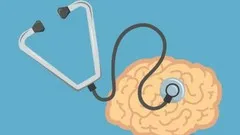
Fundamental Neuroscience for Neuroimaging 
This course provides an introduction to the fundamentals of neuroscience and neuroimaging, covering topics such as the history of neuroimaging, image formation, and different neuroimaging applications. It also introduces basic neuroscience concepts, such as structural and functional human neuroanatomy, cognitive domains, and experimental design, to help students and professionals understand the implementation of neuroimaging methods. ▼
ADVERTISEMENT
Course Feature
![]() Cost:
Cost:
Free
![]() Provider:
Provider:
Coursera
![]() Certificate:
Certificate:
Paid Certification
![]() Language:
Language:
English
![]() Start Date:
Start Date:
17th Jul, 2023
Course Overview
❗The content presented here is sourced directly from Coursera platform. For comprehensive course details, including enrollment information, simply click on the 'Go to class' link on our website.
Updated in [March 06th, 2023]
This course, Fundamental Neuroscience for Neuroimaging, is designed to provide students and professionals with an introduction to the basic principles of neuroimaging methods as applied to human subjects research. It will cover topics such as the history of neuroimaging, an introduction to neuroimaging physics and image formation, and an overview of different neuroimaging applications, including functional MRI, diffusion tensor imaging, magnetic resonance spectroscopy, perfusion imaging, and positron emission tomography imaging.
The course will begin with a review of the history of neuroimaging, from the early days of X-ray imaging to the development of modern neuroimaging techniques. This will be followed by an introduction to neuroimaging physics and image formation, including an overview of the different types of imaging modalities and their respective strengths and weaknesses.
Next, the course will provide an overview of different neuroimaging applications, including functional MRI, diffusion tensor imaging, magnetic resonance spectroscopy, perfusion imaging, and positron emission tomography imaging. Each will be reviewed in the context of their specific methods, source of signal, goals, and limitations.
The course will also introduce basic neuroscience concepts necessary to understand the implementation of neuroimaging methods, including structural and functional human neuroanatomy, cognitive domains, and experimental design. This will provide students and professionals with the necessary background to understand the implementation of neuroimaging methods in research and clinical practice.
Finally, the course will conclude with a discussion of the ethical considerations of neuroimaging research and clinical practice. This will include an overview of the ethical principles of research and clinical practice, as well as a discussion of the potential risks and benefits of neuroimaging.
Overall, this course will provide students and professionals with an introduction to the basic principles of neuroimaging methods as applied to human subjects research. It will provide an overview of the history of neuroimaging, an introduction to neuroimaging physics and image formation, and an overview of different neuroimaging applications. Additionally, it will introduce basic neuroscience concepts necessary to understand the implementation of neuroimaging methods, as well as a discussion of the ethical considerations of neuroimaging research and clinical practice.
[Applications]
Upon completion of this course, participants should be able to understand the basic principles of neuroimaging methods, the neuroscience concepts and terminology necessary for a basic understanding of neuroimaging applications, and the different neuroimaging applications. They should also be able to apply the knowledge gained from this course to their own research and clinical practice.
[Career Paths]
1. Neuroimaging Technician: Neuroimaging Technicians are responsible for operating and maintaining imaging equipment, such as MRI and CT scanners, and performing imaging procedures on patients. They must be knowledgeable in the operation of the equipment and the safety protocols associated with it. As technology advances, Neuroimaging Technicians must stay up to date on the latest developments in the field.
2. Neuroimaging Scientist: Neuroimaging Scientists are responsible for designing and conducting research studies using neuroimaging techniques. They must be knowledgeable in the principles of neuroimaging, as well as the neuroscience concepts necessary to understand the implementation of neuroimaging methods. Neuroimaging Scientists must also be able to interpret the data collected from the imaging studies and draw meaningful conclusions from it.
3. Neuroimaging Analyst: Neuroimaging Analysts are responsible for analyzing the data collected from neuroimaging studies. They must be knowledgeable in the principles of neuroimaging, as well as the neuroscience concepts necessary to understand the implementation of neuroimaging methods. Neuroimaging Analysts must also be able to interpret the data collected from the imaging studies and draw meaningful conclusions from it.
4. Neuroimaging Educator: Neuroimaging Educators are responsible for teaching and training students and professionals in the principles of neuroimaging and neuroscience. They must be knowledgeable in the principles of neuroimaging, as well as the neuroscience concepts necessary to understand the implementation of neuroimaging methods. Neuroimaging Educators must also be able to explain the concepts in a way that is understandable to students and professionals. As technology advances, Neuroimaging Educators must stay up to date on the latest developments in the field.
[Education Paths]
1. Bachelor of Science in Neuroscience: A Bachelor of Science in Neuroscience is a four-year degree program that provides students with a comprehensive understanding of the brain and nervous system. Students will learn about the anatomy and physiology of the brain, as well as the development and function of the nervous system. They will also gain an understanding of the various neuroimaging techniques used to study the brain, such as functional magnetic resonance imaging (fMRI), positron emission tomography (PET), and diffusion tensor imaging (DTI). This degree program is becoming increasingly popular as the demand for neuroimaging professionals grows.
2. Master of Science in Neuroimaging: A Master of Science in Neuroimaging is a two-year degree program that provides students with a comprehensive understanding of the various neuroimaging techniques used to study the brain. Students will learn about the principles of neuroimaging, the different types of neuroimaging techniques, and the applications of neuroimaging in clinical practice and research. This degree program is becoming increasingly popular as the demand for neuroimaging professionals grows.
3. Doctor of Philosophy in Neuroscience: A Doctor of Philosophy in Neuroscience is a four-year degree program that provides students with a comprehensive understanding of the brain and nervous system. Students will learn about the anatomy and physiology of the brain, as well as the development and function of the nervous system. They will also gain an understanding of the various neuroimaging techniques used to study the brain, such as functional magnetic resonance imaging (fMRI), positron emission tomography (PET), and diffusion tensor imaging (DTI). This degree program is becoming increasingly popular as the demand for neuroimaging professionals grows.
4. Master of Science in Cognitive Neuroscience: A Master of Science in Cognitive Neuroscience is a two-year degree program that provides students with a comprehensive understanding of the cognitive processes of the brain. Students will learn about the principles of cognitive neuroscience, the different types of cognitive neuroscience techniques, and the applications of cognitive neuroscience in clinical practice and research. This degree program is becoming increasingly popular as the demand for cognitive neuroscience professionals grows.
Pros & Cons

Interesting topics

Explains fundamentals of neuroimaging

Good introduction to neuroscience

Easy to understand

Skilled presenter

Good foundation in understanding basics

Amazing opportunity to learn.

Not too engaging

Physics part of MRI not explained well

Boring professor

Not interactive.
Course Provider

Provider Coursera's Stats at AZClass
Discussion and Reviews
0.0 (Based on 0 reviews)
Explore Similar Online Courses

Biochemistry

Developing Effective Policies to Build the Impact Economy

Python for Informatics: Exploring Information

Social Network Analysis

Introduction to Systematic Review and Meta-Analysis

The Analytics Edge

DCO042 - Python For Informatics

Causal Diagrams: Draw Your Assumptions Before Your Conclusions

Whole genome sequencing of bacterial genomes - tools and applications

Control Your Subconscious Mind: Neuroscience Hidden Secrets

Perform an Excellent Neurological Bedside Exam

Brain and Behavioral Science Fundamentals
 Related Categories
Related Categories
 Popular Providers
Popular Providers
Quiz
 Submitted Sucessfully
Submitted Sucessfully
1. What is the main purpose of this course?
2. Which of the following is NOT a topic covered in this course?
3. What is the goal of neuroimaging methods?
4. What is the main purpose of neuroimaging?
Correct Answer: To study the structure and function of the brain.


Start your review of Fundamental Neuroscience for Neuroimaging